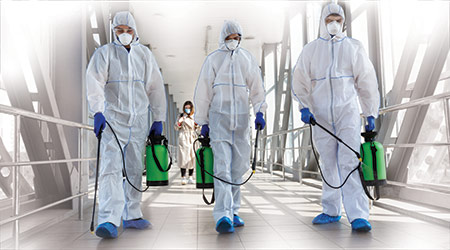
While the sheer volume of buildings, staff and departments makes a college setting among the toughest to manage during an outbreak, Ada Baldwin, director of University Housekeeping at North Carolina State University, Raleigh, North Carolina, credits ongoing partnerships with the university's Environmental Health and Public Safety (EHS) and Emergency Management and Mission Continuity (EMMC) departments for minimizing the amount of procedural change. Routine communication across multiple parties ensured all aspects of the cleaning department were kept up to speed, eliminating the need for last-minute supply adjustments and training.
"University Housekeeping did not have to shift away from the products, supplies, equipment and cleaning methods that are being used," says Baldwin. "EHS confirmed that our disinfectants are on the EPA's list N: Disinfectants for Use Against SARS-CoV-2 and our equipment — from ergonomic and maneuverable scrubbers to microfiber mops and dusters along with our protocols — are capable of meeting proper cleaning standards."
For Herman and his staff, the checklist of tasks hasn't changed much since the onset of the pandemic, but the increase in vacated facilities provides an otherwise-rare opportunity to take on important projects.
"We found that a lot of people in the City of Austin are teleworking, so that's actually giving us the opportunity for projects that we wouldn't be able to take on," he says. "Deep cleaning the floors and carpets and high dusting on light covers are just a few of the projects we wouldn't be able to normally do other than on weekends. So that's been a silver lining."
Major projects aside, Herman says elevating the cleaning frequencies of high-touchpoints has been the biggest shift, particularly in break rooms. Refrigerator handles, door and cupboard knobs, light switches and push levers are just a few of the surfaces that are now undergoing the two-step cleaning and disinfecting process three to four times per day.
From a management standpoint, both Brewer and Herman noted the implementation and enforcement of social distancing during cleaning shifts as a major challenge. Brewer says the soft closure of the Salt Lake City School District eliminates the concern of separating custodial crews from teachers and staff. Separating the custodians from themselves, however, has been an imperfect and ongoing practice.
When it comes to completing some of the more comprehensive tasks, Brewer says the timetable is inevitably longer with social distancing rules; an accepted reality for the time being.
"We've been told to bring half of our crew during the day and the other half during a swing shift. We give them orders, but they can't work together," says Brewer. "If you're stripping a floor, you're doing it on your own. We've been harsh with our staff telling them to socially distance and in high schools with larger crews. It's difficult to enforce, but we check on them routinely."
Herman expressed similar challenges enforcing social distancing, notably in the breakroom of several facilities where custodians were sharing tables. When possible, he took it upon himself to alter the setups and maximize spacing.
"One room had a portable wall that we could push back, and we also situated the tables to be 6 feet apart while not allowing more than three people in the break room at a time. That was for their safety," says Herman.
Digital Training And Communication
With the pandemic requiring custodians to undertake unique protocols such as the increased use of PPE, refresher training is more important than ever. But as Brewer points out, 6-foot spacing guidelines and the banning of gatherings larger than 10 people make in-person training sessions either inefficient or downright ineffective.
Through a pre-pandemic decision that has since proven pivotal, Brewer helped the district design a YouTube channel with videos detailing every aspect of different custodial protocols. From chemical usage guidelines to equipment tutorials, every member of the staff has immediate access to what has essentially been turned into a digital handbook.
"I didn't want our custodians to have to log onto a computer in their office, taking time out of their day to get clarification. Instead they can just pull out their phone in the field and find the answers they need," says Brewer. "We recently made a training video on proper PPE use, and all we needed to do was upload it onto our channel and alert our staff. All custodians and management were trained on the subject in a matter of hours, giving them the flexibility to educate themselves on their own time."
Brewer believes the channel not only has accessibility advantages, but steers more favorably to the next wave of custodians.
"If the access to training is convenient, they are more likely to use it. We had a custodian in his 50s who gave the YouTube channel a shot and he had it loaded up within 10 seconds," says Brewer. "As for our younger staff that spends a lot of time on smartphones, we absolutely have to move our training to their preferred medium."
Taking a similar approach to mobile convenience, Herman utilizes the Microsoft Team platform both for training sessions and daily check-ins. At minimum, he'll check in near the end of shifts for a quick call for questions or clarifications. The easy accessibility throughout the day has been particularly valuable — especially with the introduction of PPE and other evolving requirements to the typical workload.
Managing Inventory Amid The COVID-19 Pandemic
Connecting With Staff And Maintaining Morale

 The Down and Dirty on Cleaning in Virus Season
The Down and Dirty on Cleaning in Virus Season How Surfactant Use is Expanding in Commercial Cleaning
How Surfactant Use is Expanding in Commercial Cleaning